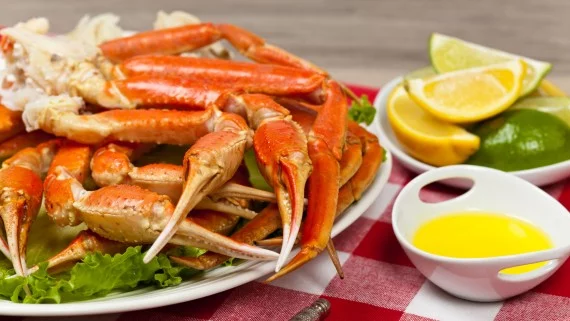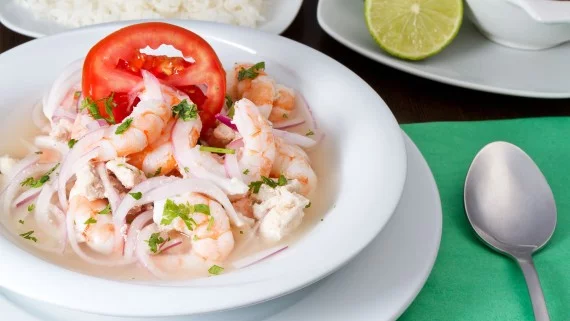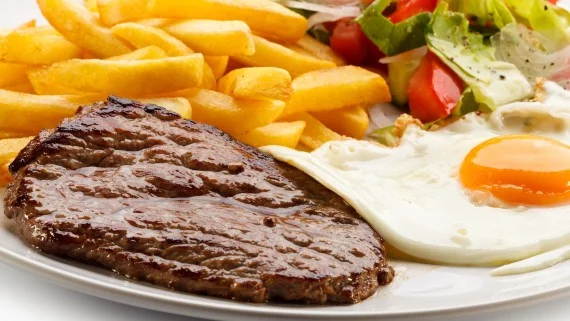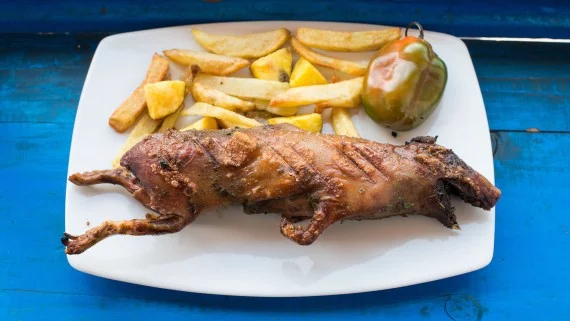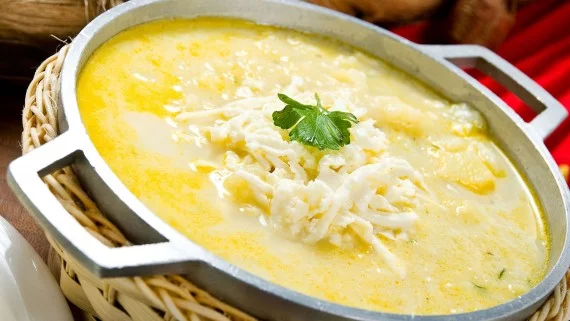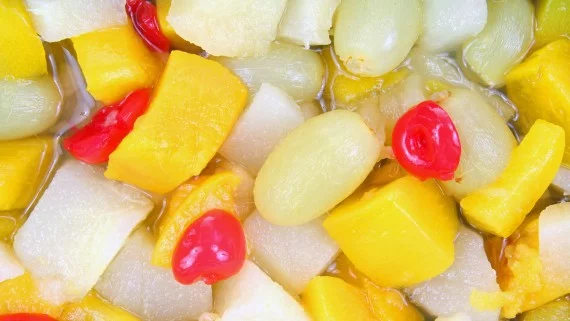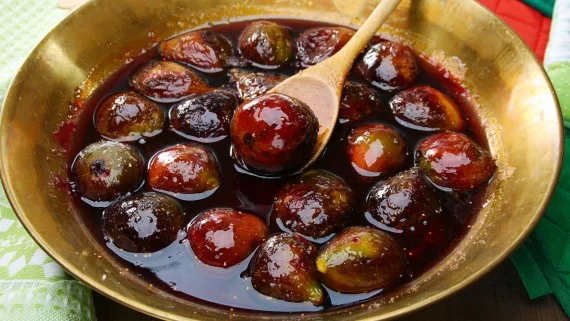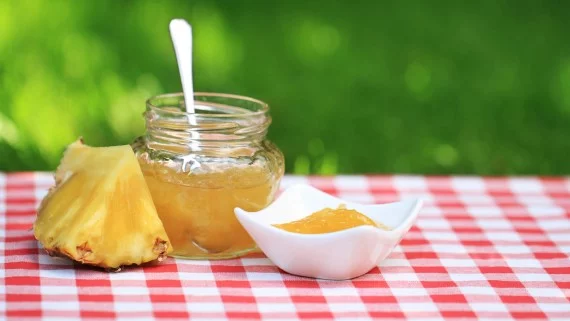Ecuadorian gastronomy is enriched by the different natural regions that make up the country: the coast, the mountains, the Galapagos Islands and the eastern region. Dishes and desserts are prepared with fish, seafood, meat, fruits and a variety of aromatic herbs. The natives of Ecuador often refer to their typical dishes as "Creole food."
Below you have an index with all the points that we are going to deal with in this article.
Article Index
- 1.
- 1.1.
- 1.2.
- 1.3.
- 1.4.
- 1.5.
- 1.6.
- 1.7.
- 1.8.
- 1.9.
- 1.10.
- 1.11.
- 1.12.
- 1.13.
- 1.14.
- 2.
- 2.1.
- 2.2.
- 2.3.
- 2.4.
- 2.5.
- 2.6.
- 2.7.
- 2.8.
- 2.9.
Main courses
Ecuador's main dishes are characterized by a strong presence of shellfish and fish, mainly because the country has a wide coastline capable of providing the country with a large number of marine products.
The banana, as well as the different Ecuadorian corns, are indispensable ingredients in Ecuadorian cuisine. Finally, in terms of meats, beef, chicken, sheep and guinea pig stand out. In what follows we list the most popular main dishes in Ecuador.
Bolon de verde
Bolón de verde is considered a national dish of the Republic of Ecuador and has the green banana as its star ingredient, of which Ecuador is one of the largest producers worldwide.
As its name suggests, the bolón de verde consists of a ball about the size of a fist that is prepared from a dough made with green plantain, which can either be roasted or fried previously. This dough is prepared manually until the mixture is homogeneous and salt and some additional ingredient are added, such as cheese or fried meat.
Once kneaded, it can be eaten directly or fried in oil until the outside is golden and crisp.
Crabby
Up to fourteen different species of crabs are raised in the coastal zone of Ecuador, although, however, not all are edible. Pangora, crabs, blue and red are those that are used in Ecuadorian cuisine, specifically for the preparation of the famous Ecuadorian crab.
For its preparation, it is necessary to boil the crustaceans previously together with the dressing, which is prepared with white onion, coriander, black pepper, oregano, cumin, salt, green plantains and ripe plantains. The crab, in addition, is usually eaten accompanied by a salad that is prepared with onion, canguil and chifles.
Ceviche
The ceviche, which can also be written seviche, sebiche o cebiche it can be meat, fish or seafood. It is considered as the star dish in Ecuadorian gastronomy.
When it is meat, it consists of meat marinated with citrus dressings, such as lemon, lime or sour orange, among others, as well as chili, coriander, avocado, tomato or jicama. If it is fish, innumerable types of shellfish and fish can be used, among which are octopus, squid, lobster, shrimp, etc.
Top Loin
Churrasco is another of the most popular dishes both in Ecuador and throughout Latin America. It consists of a beef cutlet cooked on the grill or on the grill and accompanied by eggs, rice, potatoes, onion, garlic, olive oil and other ingredients, as well as some sauces.
The secret to preparing a good Ecuadorian churrasco is that the meat is well seasoned with onion, garlic, salt, olive oil and a touch of cumin and pepper.
Pumpkin cream
The pumpkin, also known as pumpkin It is a type of vegetable of American origin considered as a variant within the family of the same family as the pumpkin (scientific name: cucurbits).
The pumpkin has been consumed throughout Latin America since the times of the Aztec Indians and was introduced to Europe after the conquest of America by the Spanish. Thus, cream of squash is a puree made from boiled squash and, later, crushed together with chicken or vegetable broth.
Roasted cuy
The guinea pig is a species of rodent that weighs about 1 kg and can be found in the Andean region of South America, especially in Peru, Bolivia, Ecuador and Colombia. For this reason, roasted guinea pig is a very common dish also in the gastronomy of the Peruvian Amazon.
This dish is usually eaten during holidays or special events and there is even an association in the country called Ecuadorian Chefs Association, which organizes the International Cuy Festival, in which the culinary wealth of this rodent mammal is exhibited.
Although the most popular dish is that of roasted guinea pig accompanied by potatoes, there are also other dishes in which guinea pig is the star ingredient, namely: locro de guinea pig, potato soup with guinea pig, chili pepper, guinea pig with mote, etc. If you want to know how it is prepared, we recommend this article: Roast guinea pig with potatoes recipe.
Onions
Encebollado is an original dish from the province of Guayas, in the southwest of the country, as well as from Manabí, hence the name manabita onion o flowed. Like the crab, this dish is very popular in the coastal area in general, since it is a fish stew accompanied by yucca and pickled red onion.
The broth that accompanies the fish is made from liquefied cassava and can be seasoned with chili powder, cumin or other spices to taste. The fish used to prepare this dish is usually albacore, but it is also possible to use tuna or billfish. To accompany, you can serve rice, canguil, bread, lemon juice, chili, etc.
guatita
Along with the bolón de verde, guatita or guatita criolla is considered a national dish in Ecuador, as well as in Chile. This dish consists of a stew made from pieces of beef stomach, which are what is called waddles or also of mondongo.
The first step to prepare this stew is to boil the guatitas, which must first be thoroughly washed and cleaned with lemon.
After boiling, they are fried together with onion, tomato and peppers, as well as other dressings to taste, such as potatoes, peanut butter, peanuts, beans, coriander and other spices. It is considered a very caloric dish. Let's see the recipe step by step in the following video:
Ecuadorian Locro
Locro, locro de papa or locro de papas con queso is a classic dish from Ecuador that consists of a creamy soup made from potatoes and cheese. It is typical of the Ecuadorian Sierra and especially popular in the north of the country and Quito, where it is also known as Quito Locro.
Although its main ingredients are, as already mentioned, potatoes and cheese, the following foods are also usually added: corn, cabbage, fresh corn, peanuts, shrimp ...
There is another variant called yagualocro o llagualocro, which literally means blood locro, since it is prepared with fried blood (a food very similar to the popular blood sausage in Spain) and giblets (tripas). Avocado pieces can also be added.
Ecuadorian corn
Corn constitutes a large part of Ecuador's agricultural and nutritional heritage, since it is cultivated throughout the country, except for the páramos and areas of Andean forests that are degraded. It is grown especially in Azuay, Loja, Azuay, Bolívar and Chimborazo, among others.
There are a large number of corn species that are far from the yellow color we are used to when we talk about corn. Thus, there is purple, black, white and even red corn.
In short, corn is, along with bananas, a basic pillar of Ecuadorian cuisine. The best-known species of corn are those listed below: corn, canguil, chulpi or sweet corn, mote and morocho.
Petacones
The patacones, also called croutons o Fried, are another of the star foods in Ecuadorian cuisine, mainly because they are prepared with green plantain, one of the main indigenous products of the country.
Thus, it is about thick pieces of green or ripe banana that are fried in very hot olive oil for a few minutes until they are golden brown. Once fried, they are removed from the pan and crushed with a utensil similar to a rolling pin known as pataconera o tostonera.
After being crushed, they are returned to the pan and fried until they are completely golden and crisp. They are taken as an accompaniment to different dishes.
Banana
Ecuador is one of the main banana exporters worldwide, so much so that this fruit is considered representative of Ecuadorian gastronomy. In total, it is estimated that Ecuador provides 10% of the world's total banana production, as about 6 million tons of bananas are grown annually.
The plantation of bananas is favored by the equatorial climate, which is a subtype of the tropical climate, in which warm temperatures and humidity predominate throughout the year.
Quinoa
Quinoa, also written Quinoa It is a semi-cereal that can be found among the crops of most of the Andes, especially in countries such as Peru, Bolivia, Chile, Colombia and Ecuador. In the latter, the quinoa harvest stands out especially in the province of Chimborazo, in the central area of the Interandina Region.
This semi-cereal has the eight essential amino acids for humans, which makes it a very healthy ingredient. As food, it is used for the production of flour and also for the preparation of the famous Ecuadorian quionoa soup, as well as to obtain beer.
Catfish soup
Catfish soup or broth is very rich in phosphorus, which makes it a very rich and nutritious dish within Ecuadorian cuisine. The catfish, known in Ecuador as camchimala fish It is a species of fish of the order Siluriformes, a group that receives the common name of cat fish because they have whiskers.
For the preparation of this soup you need yucca, coriander, garlic, a head of catfish, sliced catfish, tomato, oil, cumin, pepper and salt.
Desserts
Ecuador's desserts and sweets stand out for including a large number of exotic fruits such as plantain, banana, pineapple, guava, papaya, mango, babaco, figs, coconut and a long etcetera.
It is also common to prepare jams and syrups from these ingredients for canning. There is also no lack of dulce de leche, so popular throughout Latin America. Below is a list of the most popular desserts within Ecuador.
Eat and drink
He eats and drinks is a fruit salad that in Spain is known as m. It is an easy to prepare and very refreshing dessert for which exotic and very fresh fruits are used, such as papaya, banana, pineapple, mango, ripe bananas, blackberries, etc. and it is accompanied by orange juice.
By having whole pieces of fruit and orange juice at the same time, this dessert can be eaten and, at the same time, drunk, hence its name. Although it depends on the natural sweetness of the fruits used, when you eat and drink you dream of adding sugar or honey, so that it acquires an additional sweet touch.
There are variants that add rum, cachaca or brandy, so that the eats and drinks become a cocktail.
Babaco candy
Babaco is an original fruit from South America, specifically from the Loja province, in Ecuador. Actually, it is a natural hybrid resulting from the cross between toronche and chamburo. The cultivation of babaco, like that of papaya, is due to the fact that it is an edible fruit widely consumed in the country.
Thus, dulce de babaco is a kind of syrup made from the cooking of a large mature babaco, to which sugar, water and a little cinnamon are added. Depending on the amount of water we use, it will be more liquid or thicker.
Sweet figs
Figs are a low-fat and high-carbohydrate fruit, so they are recommended for use as homemade jam. In fact, the fig sweet can be a kind of jam or it can consist of cooked figs and bathed in canning syrup.
To prepare this sweet, we will need at least 1 kg of figs and 500 grams of sugar, since it is a very sweet dessert. Also, you will need lemon juice.
Foams
Espumillas, suspiritos or suspiros are actually a popular sweet in South America, especially in Guatemala and El Salvador, as well as in Ecuador. They are a sweet similar to meringue that are colored, so that they are in different colors.
It is a kind of sugar clouds flavored with cinnamon and lemon, which are prepared based on eggs, sugar, vanilla, lemon, guava pulp and ground cinnamon.
Coconut flan
Flan is a dessert that can be eaten almost everywhere in the world, mainly because of its versatility and its simple preparation. Although the egg flan is perhaps the most popular version internationally, the coconut flan is the most traditional within Ecuador.
For its preparation, the same steps must be followed as for the preparation of any of the flan versions, except that we will need grated coconut.
Flan or pineapple cheese
Pineapple cheese is a cheese cake to which pineapple is added, very common in Ecuador. For its preparation it is not necessary to bake it, since it is served cold, which is why it is a summer dessert. Among the ingredients necessary for its preparation, you will need: unflavored gelatin, pineapple jelly, peeled and diced ripe pineapple, curd, cooking cream and sugar.
Pineapple jam or sweet
Pineapple is another exotic fruit whose cultivation is very common throughout Ecuador, which is why it is used in a large number of desserts, such as the pineapple cheese or flan that we have talked about before or the famous pineapple jam, a dessert that also known as pineapple candy.
In a similar way to sweet figs, in this jam the pineapple pieces can be left whole or crushed, always to the taste of the one who prepares it. In addition to pineapple, other ingredients are used such as: water, sugar or grated brown sugar, cinnamon, cloves, cardamom, lemon verbena and lemon juice.
Dulce de leche soufflé
Dulce de leche is an original sweet from Latin America and also receives the following names: manjar, manjar blanco, cajeta o arequipe.
It is a caramelized variant of milk that, currently, has crossed borders and has become popular outside of Latin America in countries such as France, where it is called milk jam, in Spain and in the United States.
It is used in a large number of desserts, from pancakes and ice cream, to cakes and alfajores, among others. In Ecuador, the famous soufflés filled with dulce de leche are prepared.
Three milk cake
The tres leches cake or tres leches cake is a popular moist cake throughout Latin America that, as its name suggests, is prepared with a cream that is made from four types of milk: evaporated milk, condensed milk, cream milk and fluid milk.
In addition, meringue is added, which is prepared with eggs and sugar, and sponge cake for the base. It is also very popular with the desserts of the canadian gastronomy.
This article has been shared 1162 times. We have spent many hours collecting this information. If you liked it, share it, please:


